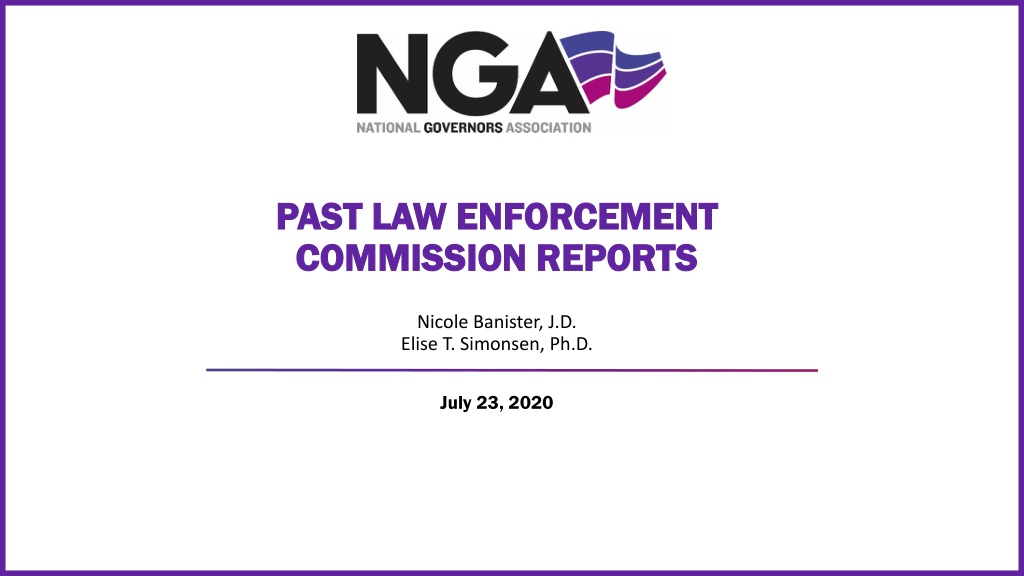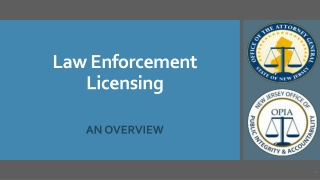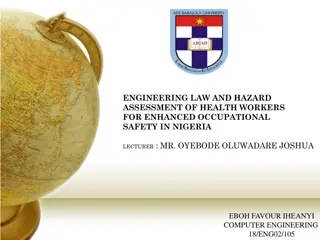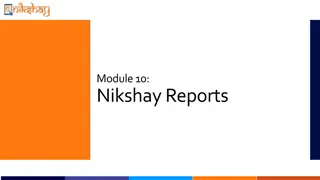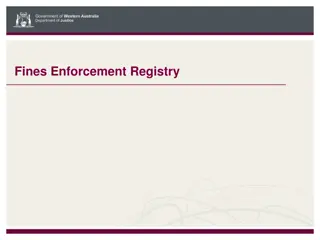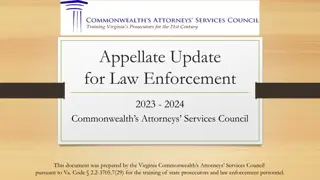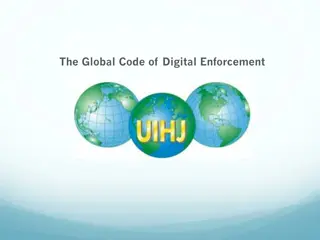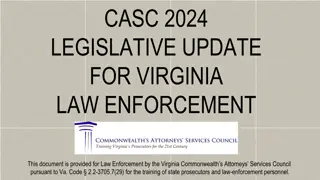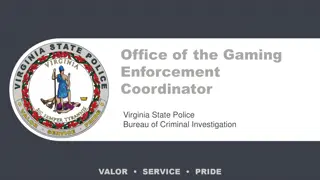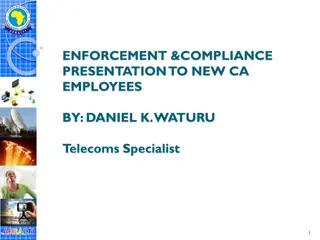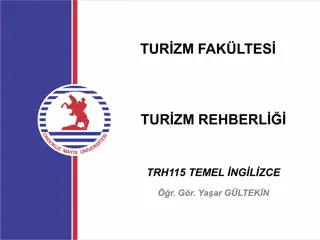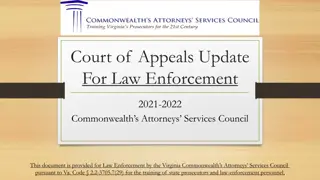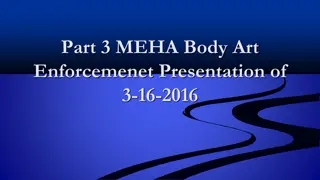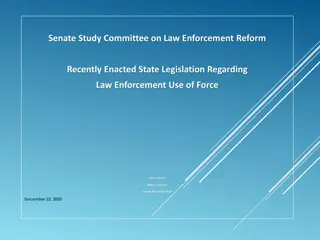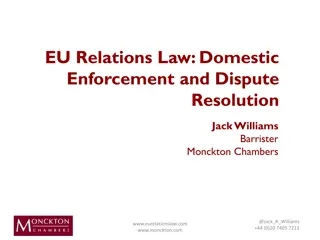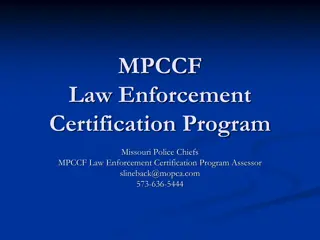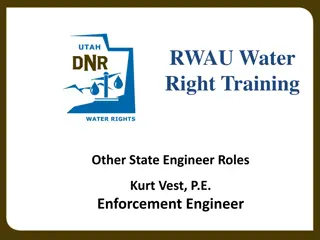Past Law Enforcement Commission Reports Overview
This document provides an overview of past law enforcement commission and task force reports, highlighting key themes and recommendations. It discusses the importance of procedural justice, community engagement, policies and procedures, recruitment, training, retention, and officer wellness. The report includes insights from notable reports like the Kerner Commission and the President's Task Force on 21st Century Policing.
Download Presentation

Please find below an Image/Link to download the presentation.
The content on the website is provided AS IS for your information and personal use only. It may not be sold, licensed, or shared on other websites without obtaining consent from the author. Download presentation by click this link. If you encounter any issues during the download, it is possible that the publisher has removed the file from their server.
E N D
Presentation Transcript
PAST LAW ENFORCEMENT PAST LAW ENFORCEMENT COMMISSION REPORTS COMMISSION REPORTS Nicole Banister, J.D. Elise T. Simonsen, Ph.D. July 23, 2020
Overview I. Introduction to past commission and task force reports II. Summary of key themes and recommendations III.Appendix: state action steps 2
Past Commission and Task Force Reports Report of The National Advisory Commission on Civil Disorders Kerner Commission (1967-1968) President s Task Force on 21st Century Policing Final Report (2014-2015) Minnesota Working Group on Police-Involved Deadly Force Encounters Report (2019-2020) U.S. Department of Justice Investigation of the Ferguson Police Department (2015) 3
Key Themes 1. Procedural Justice and Legitimacy 2. Community Engagement 3. Policies and Procedures 4. Recruitment, Training, and Retention 5. Officer Wellness 4
Theme 1: Procedural Justice and Legitimacy Past commissions suggest law enforcement agencies can strengthen public trust by ensuring policies and practices are developed with community input and taking a guardian approach to policing. Includes recommendations related to: Implementing internal and external procedural justice practices Strengthening public trust De-militarizing law enforcement 5
Recommendations: Procedural Justice and Legitimacy Implementing internal and external procedural justice practices Kerner Commission: Expand opportunities for community participation in policy development: Improve political representation Creation of institutional channels for community action Expand legal services Provide legislative hearings on community challenges 21st Century Policing: Law enforcement agencies should collaborate with community members to develop policies in communities disproportionately affected by crime: By deploying resources that aim to reduce crime by improving relationships, greater community engagement, and cooperation. 6
Recommendations: Procedural Justice and Legitimacy Strengthening public trust: Kerner Commission: Acknowledge the reservoir of grievances within Black communities related to prejudice, discrimination, and policing practices. 21st Century Policing: Acknowledge the role of policing in past and present injustice and discrimination and recognize how it is a hurdle to the promotion of community trust. De-militarizing law enforcement: Kerner Commission: Condemns moves to equip police departments with mass destruction weapons, such as automatic rifles, machine guns, and tanks. 21st Century Policing: Law enforcement culture should embrace a guardian mindset to build public trust and legitimacy. 7
Theme 2: Community Engagement Past commissions suggest community members should be provided opportunities to engage with law enforcement to foster public safety. Citizens should proactively participate in law enforcement policies from development to feedback. Includes recommendations related to: Investing in community support Utilizing public-facing communication and technological tools Involving community input in police practice and policies Providing opportunities for citizens to provide feedback, grievances, and oversight 8
Recommendations:Community Engagement Investing in community support Kerner Commission: Develop multi-service centers. 21st Century Policing: Adopt policies with a preference for seeking least harm. Minnesota Working Group: Increase investment in community-based, mental health, and trauma-informed services statewide. Ferguson Report: Work with school actors to develop and implement policy consistent with best practices to address disciplinary issues in schools. Utilizing public-facing communication and technological tools 21st Century Policing: Adopt model policies and best practices for technology-based community engagement that increases community trust and access. Increase transparency and accessibility, provide access and information. 9
Recommendations:Community Engagement Involving community input in police practice and policies Kerner Commission: Improve and foster opportunities for citizen leadership to participate in shaping decisions and policies that affect their community. 21st Century Policing: Schedule regular forums and meetings where community members can interact with police and share feedback. Involve community in developing and evaluating policies and procedures. Providing opportunities for citizens to provide feedback, grievances, and oversight Kerner Commission: Create a specialized agency with adequate staff and resources to handle, investigate, and make recommendations on citizen complaints. 21st Century Policing: Establish a Serious Incident Review Board comprising sworn staff and community members to review cases involving officer involved shootings and other serious incidents that have the potential to damage community trust or confidence in the agency. 10
Theme 3: Policies and Procedures Past commissions suggest law enforcement agencies should develop policies and guidelines for policing that reflect community values and prioritize public safety. Includes recommendations related to: Improving patrolling and policing strategies Specifying use of force standards Increasing data collection and reporting Considering the use of technology 11
Recommendations: Policies and Procedures Improving patrolling and policing strategies: Kerner Commission: Recognize the impact of high police presence in communities of color, and low-income communities. Establish guidelines covering how communities and law enforcement agencies will handle minor disputes, decisions of whether to arrest and the use of alternatives to arrests, and selection and use of investigation methods, etc. 21st Century Policing: Refrain from practices requiring officers to issue a predetermined number of tickets, citations, arrests, or summonses, or to initiate investigative contacts with citizens for reasons not directly related to improving public safety. Ferguson Report: Shift from policing to raise revenue to policing in partnership with the entire community. 12
Recommendations: Policies and Procedures Specifying use of force standards: Kerner Commission: Develop and adopt policy guidelines to assist officers in making critical decisions. Craft guidelines governing the use of control equipment and provide alternatives to the use of lethal weapons. 21st Century Policing: Law enforcement agencies should have comprehensive policies on the use of force, including training, investigations, prosecutions, data collection, and information sharing, that are clear, concise, and openly available for public inspection. Minnesota Working Group: The state, with law enforcement and community stakeholders, should review the existing use-of-force standards to ensure there is a focus on the sanctity of life, and require that the use-of-force be reasonable, necessary, and proportionate. 13
Recommendations: Policies and Procedures Increasing data collection and reporting: 21st Century Policing: Law enforcement agencies should be encouraged to collect, maintain, and analyze demographic data on all detentions (stops, frisks, searches, summons, and arrests). This data should be disaggregated by school and non-school contacts. Minnesota Working Group: Establish a statewide data-collection and reporting system that tracks all police-involved deadly force encounters. Adopt data practices that promote transparency, openness, and accountability. Ferguson Report: Measure and evaluate individual, supervisory, and agency police performance on community engagement, problem-oriented-policing projects, and crime prevention. 14
Recommendations: Policies and Procedures Considering the use of technology: 21st Century Policing: The implementation of appropriate technology should be designed considering local needs and aligned with national standards. 15
Theme 4: Recruitment, Training, and Education Past commissions suggest law enforcement agencies should prioritize recruiting and hiring officers that reflect the community. Training and education should align with best practices and continue throughout careers. Includes recommendations related to: Utilizing State Peace Officer Standards and Training Boards (POSTs) Including crisis intervention and implicit bias training Continuing training on-the-job 16
Recommendations: Recruitment, Training, and Education Utilizing State Peace Officer Standards and Training Boards (POSTs) 21st Century Policing: Include lessons on improving social interaction as well as tactical skills in basic officer training, such as critical thinking, social intelligence, implicit bias, fair and impartial policing, and historical trauma. Minnesota Working Group: Updates to the training curricula should include sanctity of life, proportionality, imminent threat, de-escalation tactics, self-defense, communication skills, and rendering aid and should model practices in communication, transparency and openness. Guidance to local governments supporting workforce diversity. 17
Recommendations: Recruitment, Training, and Education Including crisis intervention and implicit bias training: 21st Century Policing: Both basic recruit and in-service training should include Crisis Intervention Training (CIT), which equips officers to deal with individuals in crisis or living with mental disabilities, and content around recognizing and confronting implicit bias and cultural responsiveness. Minnesota Working Group: Both basic recruit and in-service training should include components on crisis intervention, mental health, and developmental, physical, and intellectual disabilities. 18
Recommendations: Recruitment, Training, and Education Continuing training on-the-job : 21st Century Policing: Engage community members in the training process Consider training innovation hubs Provide leadership training Encourage and incentivize higher education for officers Ferguson Report: Training on community policing: Advantages: crime-prevention, officer safety, and anti- discrimination Mechanics: officer s role in implementing 19
Theme 5: Officer Wellness Past commissions acknowledge the risks and harms officers encounter and provide recommendations for improving officer safety and wellness. Includes recommendations related to: Accessing mental health resources Improving officer safety Addressing law enforcement culture 20
Recommendations: Officer Wellness Accessing mental health resources: 21st Century Policing: The U.S. DOJ should enhance and further promote its multi-faceted officer safety and wellness initiative. Minnesota Working Group: Expand resources, and increase statewide awareness of existing resources, to improve the mental health and wellness of first responders and dispatchers. Establish or participate in evidence-informed mental health and wellness programs: 1. Peer Support Teams 2. Crisis Intervention Stress Management (CISM) Improving officer safety: 21st Century Policing: Officers should be provided with individual tactical first aid kits and anti-ballistic vests. Adopt policies that require officers to wear seat belts and bullet-proof vests. 21
Recommendations: Officer Wellness Addressing law enforcement culture: 21st Century Policing: Agencies should promote safety and wellness at every level of the organization and should be expressed through changes in procedures, requirements, attitudes, and behaviors. 22
Q & A 24
Appendix Additional information from commission reports on specific action steps related to the recommendations 25
Action Steps:Community Engagement Establish Formal Community Advisory Boards: Board should assist in developing crime prevention strategies and agencies policies (21 Century Policing) Statewide Examples: New Jersey Governor Jon Corzine created an Advisory Committee on Police Standards through Executive Order. Ohio Governor John Kasich created the Ohio Task Force on Community- Police Advisory Boards through Executive Order. Establish Neighborhood Action Task Forces TFs should open channels of communication between government officials and community residents. Statewide Example: Oregon statutorily requires each county to convene a local public safety coordinating council (LPSCC) to coordinate with local criminal justice stakeholders and the Oregon Criminal Justice Commission. Leveraging state dollars, the LPSCCs must recommend a spending plan for criminal justice and public safety in the community and coordinate local criminal justice policy among affected justice entities. 26
Action Steps: Procedural Justice and Legitimacy Kerner Commission: State cooperation in providing municipalities with the jurisdictional tools needed to deal with their problems; a fuller measure of financial aid to urban areas; and the focusing of the interests of suburban communities on the physical, social, and cultural environment of the central city. 21st Century: In order to achieve internal legitimacy, law enforcement agencies should involve employees in the process of developing policies and procedures. Law enforcement agency leadership should examine opportunities to incorporate procedural justice into the internal discipline process, placing additional importance on values adherence rather than adherence to rules. Union leadership should be partners in this process. In order to achieve external legitimacy, law enforcement agencies should involve the community in the process of developing and evaluating policies and procedures. Use of physical control equipment and techniques against vulnerable populations can undermine public trust and should be used as a last resort. Law enforcement agencies should carefully consider and review their policies towards these populations and adopt policies if none are in place. 27
Action Steps:Community Engagement Establish a Serious Incident Review Board: Comprised of sworn staff and community members to review cases involving officer involved shootings and other serious incidents that have the potential to damage community trust or confidence in the agency (21st Century Policing) Develop a Joint Office including the AG, Public Safety, and Stakeholders: Work with the communities in conflict by mediating disputes, enhancing community capacity to independently prevent and resolve future conflicts and undertake restorative practices. The office would work with community groups, public officials, law enforcement, and other relevant stakeholders to promote healing and restoration, and resolve community conflict (Minnesota p. 6). This joint office is similar to U.S. COPS Office. Develop Community and School-based Programs Mitigate punitive and authoritarian solutions to teen problems. (21st Century Policing) 28
Action Steps: Policies and Procedures Improving patrolling and policing strategies: 21st Century: Encourage and facilitate multidisciplinary initiatives and teams for public safety efforts and strategies, including: 1. Involving public health and behavioral health agencies, 2. Providing funding, training for peer support counselors and trauma-informed specialists, and 3. Crisis intervention team approach strategies. Reform policies and procedures that push children into the juvenile justice system, and support and strengthen community-based and school-based alternatives. Work with schools to encourage the creation of alternatives to student suspension and expulsion through restorative justice practices. 29
Action Steps: Policies and Procedures Specifying use of force standards: 21st Century: Law enforcement agency policies for training on use of force should emphasize de-escalation and alternatives to arrest or summons in situations where appropriate. (pg. 20) Use of force policies should also mandate external and independent criminal investigations in cases of police use of force resulting in death, officer-involved shootings resulting in injury or death, or in- custody deaths. (pg. 21) The task force encourages policies that mandate the use of external and independent prosecutors in cases of police use of force resulting in death, officer-involved shootings resulting in injury or death, or in- custody deaths. (pg. 21) 30
Action Steps: Policies and Procedures Increasing data collection and reporting: 21st Century: Policies on use of force should also require agencies to collect, maintain, and report data to the Federal Government on all officer-involved shootings, whether fatal or nonfatal, as well as any in-custody death. (pg. 21) Minnesota Working Group: Require all law enforcement agencies to report all deadly force encounters and uses of force resulting in serious or great bodily harm or death to the Bureau of Criminal Apprehension (BCA) for inclusion in the FBI s national Use-of-force database. Ferguson Report: Develop and implement a plan for broader collection of stop, search, ticketing, and arrest data that includes pedestrian stops, enhances vehicle stop data collection, and requires collection of data on all stop and post-stop activity, as well as location and demographic information (pg. 92) Considering the use of technology: 21st Century: Provide training to help law enforcement agencies learn, adapt, and implement technology tools and tactics that are consistent with best practices. 31
Action Steps: Recruitment, Training, and Education 21st Century Develop and disseminate a toolkit on how law enforcement agencies and training programs can integrate community members into this training process (p. 54) Support and encourage cross-discipline leadership training. (p. 55) Law enforcement agencies should implement ongoing, top down training for all officers in cultural diversity and related topics that can build trust and legitimacy in diverse communities. (p. 58) Law enforcement agencies should implement training for officers that covers policies for interactions with the LGBTQ population, including issues such as determining gender identity for arrest placement, the Muslim, Arab, and South Asian communities, and immigrant or non-English speaking groups, as well as reinforcing policies for the prevention of sexual misconduct and harassment. (p. 58) 32
Action Steps: Recruitment, Training, and Education Minnesota Working Group All peace officers (full or part time) should be trained in crisis intervention and mental health crises; conflict management and mediation; and recognizing and valuing community diversity and cultural differences that includes implicit bias training. The Legislature should incorporate the current expansion of funds into the State base budget to meet this goal. The Legislature should require the inclusion of procedural justice and historical community trauma as part of the existing community diversity and implicit bias training requirements. Law enforcement agencies should include components on crisis intervention, mental health, and developmental, physical, and intellectual disabilities in basic recruit training and in-service training. These training components should be developed with input and collaboration from people with developmental, physical, and intellectual disabilities. The Legislature should fund the inclusion of dispatchers in this training. 33
Action Steps: Officer Wellness 21st Century: Pension plans should recognize fitness for duty examinations as definitive evidence of valid duty or non-duty related disability. (pg. 64) Public Safety Officer Benefits (PSOB) should be provided to survivors of officers killed while working, regardless of whether the officer used safety equipment (seatbelt or anti- ballistic vest) or if officer death was the result of suicide attributed to a current diagnosis of duty-related mental illness, including but not limited to post-traumatic stress disorder (PTSD). (pg. 64) The U.S. Department of Justice should fund additional research into the efficacy of limiting the total number of hours an officer should work within a 24 48-hour period, including special findings on the maximum number of hours an officer should work in a high risk or high stress environment (e.g., public demonstrations or emergency situations). (pg. 65) Minnesota Working Group: The Department of Public Safety should develop and promote a comprehensive Officer Mental Health and Wellness tool kit to promote officer resilience, ability to manage exposure to trauma, and improve physical and mental health outcomes. (pg. 14) The State of Minnesota and the Department of Public Safety should establish a full-time position to coordinate Peer Support, Critical Incident Stress Management (CISM), and officer safety and wellness efforts statewide. (pg. 15) 34
